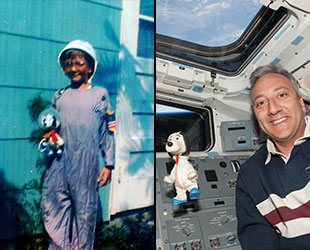How NASA's Apollo Missions Inspired This Astronaut to Aim for Space
This summer, people around the world will celebrate the 50th anniversary of the first Apollo moon landing. An estimated 600 million people around the world watched the first lunar steps on their black-and-white television sets, transfixed by the history unfolding in front of their eyes. One of those people watching as astronauts Buzz Aldrin and Neil Armstrong walked on the moon was a young Mike Massimino, who would go on to become a NASA astronaut himself. In a conversation with Space.com, Massimino described the experience of seeing the lunar landing and how it inspired him to become an astronaut.
"I was 6 years old when that happened," Massimino said about the Apollo 11 lunar landing. "It made quite an impression. For me, I idolized the astronauts. I thought what they were doing was really important. I thought they were really cool — I thought they were even cooler than athletes. They were rock stars.
"I remember very clearly thinking as a 6-year-old, 'This is the most important thing happening in the world today, and it's the most important thing that's ever gonna happen for another 500 years,'" Massimino continued. "I felt like I was very lucky to be alive at that time when this was happening, and I wanted to be a part of it."
Related: Talk to a 'Spaceman': Q&A with Astronaut Mike Massimino
And Massimino certainly did become a part of it. Selected as an astronaut candidate in 1996, he began his training at NASA's Johnson Space Center in 1996. Massimino served as a mission specialist, a Capcom spacecraft communicator in Mission Control and other roles until he left NASA in 2014. Massimino flew twice as an astronaut — aboard the STS-109 Columbia in 2002 and STS-125 Atlantis in 2009, which was the final Hubble servicing mission. He spent a total of 571 hours and 47 minutes in space, completing two spacewalks totaling 14 hours and 46 minutes and even sending the first tweet from space.
But an astronaut career wasn't Massimino's first choice. Massimino studied engineering, ultimately earning a Doctor of Philosophy degree in mechanical engineering from MIT. He went on to work as an engineer for IBM and later on for NASA. As an engineer, he didn't think that he fit the Apollo-era astronaut mold. While he looked up to these moonwalking men, "it was only a small group of people — military, male test pilots … as I got older, I thought, 'That can't happen. I'm not going to be a military test pilot.' But then the shuttle program seemed a little more reasonable. When I got out of college, I started learning a little bit more about it. I never considered it as a career — after college I was working as an engineer — then I started reading a little more about it." Massimino realized that even though he wasn’t a military test pilot, he could still go on to become an astronaut.
NASA's space shuttle program formally began in 1972, with the first shuttle test flight lifting off in 1977 and the first crewed flight taking off in 1981. NASA's space shuttle program, before it ended in 2011, opened up the opportunity to go to space to a much larger range of people than the Apollo program had.
Get the Space.com Newsletter
Breaking space news, the latest updates on rocket launches, skywatching events and more!

"It wasn't just military test pilots. It was engineers and scientists and the first women and the first people of color. It was a whole different ballgame now, and I thought, 'Oh, maybe this is something I could be qualified to do,'" Massimino said.
Spaceflight has continued to evolve since the days of the shuttle program. Today, commercial spaceflight works alongside government space agencies to develop new technologies, open up new opportunities for astronauts and space tourists, and push humanity farther into the cosmos.
In fact, just a few days ago, on March 2, private spaceflight company SpaceX launched the first test flight of its commercial crew vehicle, the Crew Dragon. The spacecraft's successful launch and subsequent successful docking with the International Space Station mark another step forward for the company's move to crewed spaceflight. If all continues to go according to plan, SpaceX will launch missions with astronauts onboard starting this summer.
Boeing will soon join SpaceX in these efforts, as commercial space and the opportunities it presents continue to grow and change. And just as NASA's shuttle program opened doors for astronauts like Massimino who didn't fit the mold of the Apollo era, commercial spaceflight may create more opportunities for hopeful future astronauts.
- Excerpt from 'Spaceman': Mike Massimino's First Spacewalk
- Behind the Scenes with Astronaut Mike Massimino on Big Bang Theory
- Spaceman: NASA Astronaut Mike Massimino's Space Career in Photos
- All About NASA's Apollo Moon Mission Program
Follow Chelsea Gohd on Twitter @chelsea_gohd. Follow us on Twitter @Spacedotcom and on Facebook.
Join our Space Forums to keep talking space on the latest missions, night sky and more! And if you have a news tip, correction or comment, let us know at: community@space.com.

Chelsea “Foxanne” Gohd joined Space.com in 2018 and is now a Senior Writer, writing about everything from climate change to planetary science and human spaceflight in both articles and on-camera in videos. With a degree in Public Health and biological sciences, Chelsea has written and worked for institutions including the American Museum of Natural History, Scientific American, Discover Magazine Blog, Astronomy Magazine and Live Science. When not writing, editing or filming something space-y, Chelsea "Foxanne" Gohd is writing music and performing as Foxanne, even launching a song to space in 2021 with Inspiration4. You can follow her on Twitter @chelsea_gohd and @foxannemusic.









